Table of Contents
Sleepovers are a big part of childhood, but they can be tough for parents. This guide is here to help you make sleepovers fun and restful for everyone. With 70% of kids aged 8-12 having been to at least one sleepover, they’re a big deal in growing up.
Planning a great sleepover takes some work. You need to manage the group and make sure everyone can sleep well. This guide will show you how to balance fun and rest.
We’ll talk about setting rules and dealing with problems. Our goal is to make sure sleepovers are good times that don’t ruin sleep. By the end, you’ll know how to plan sleepovers that keep everyone rested.
Quick Picks for a Fun and Healthy Sleepover
[lasso id=”32″ link_id=”374″ type=”table”]
1 Understanding Modern Sleepover Culture
Sleepovers are a big part of American culture, helping kids grow and make friends. These fun nights have changed a lot over time. They now reflect new rules and worries from parents.
The Evolution of Sleepovers in American Households
Old-school sleepovers were simple. Kids would hang out, play games, and then sleep. Now, they’re more elaborate, with themes, activities, and tech.
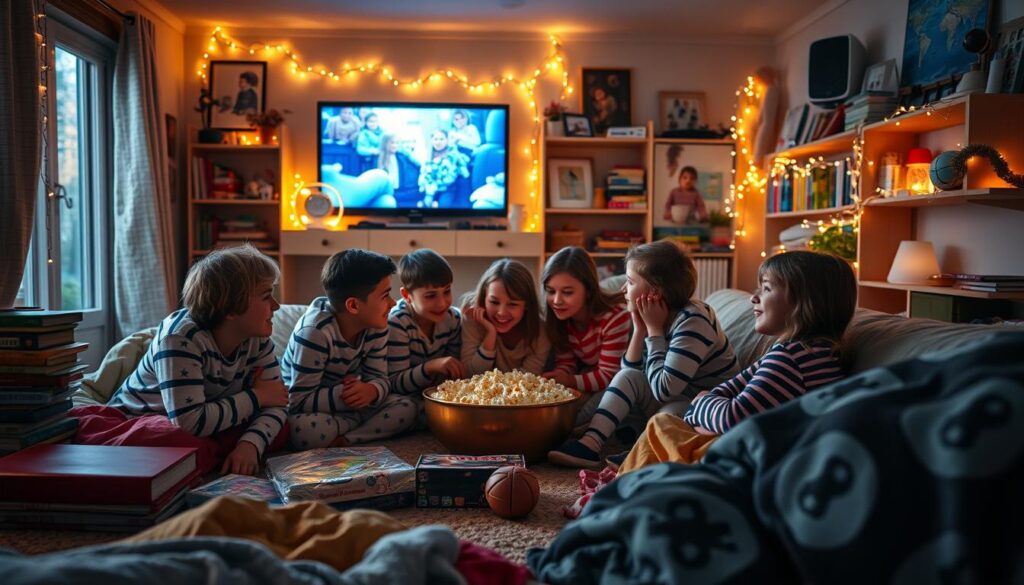
Current Trends and Expectations
Today’s sleepovers include movie nights, gaming, and spa days. Parents want these events to be safe and structured. A survey found 70% of parents worry about bad behavior, showing the need for rules.
Social Impact on Children’s Development
Sleepovers are key for kids’ growth. They teach independence, social skills, and create memories. These experiences help kids handle friendships and new places.
| Positive Impacts | Potential Concerns |
|---|---|
| Improved social skills | Safety issues |
| Increased independence | Exposure to inappropriate content |
| Stronger friendships | Disrupted sleep patterns |
| Problem-solving abilities | Homesickness |
Despite the benefits, parents need to know about sleepover trends. They should also set limits to make sure everyone has a good time.
2 Planning the Perfect Sleepover Setup
Planning a sleepover can be both fun and challenging. A recent survey found that 45% of parents say sleepovers are a common weekend activity for their kids. To host a successful sleepover, start by picking the right date and guest list.
Preparing for a sleepover is more than just setting up sleeping bags. Here are some important things to consider:
- Guest count: The ideal number is between 4 to 8
- Activities: 78% of sleepovers include games or crafts
- Food: 80% of kids love late-night snacks
- Sleep arrangements: Make sure everyone has a comfy spot
[lasso id=”30″ link_id=”365″ type=”table”]
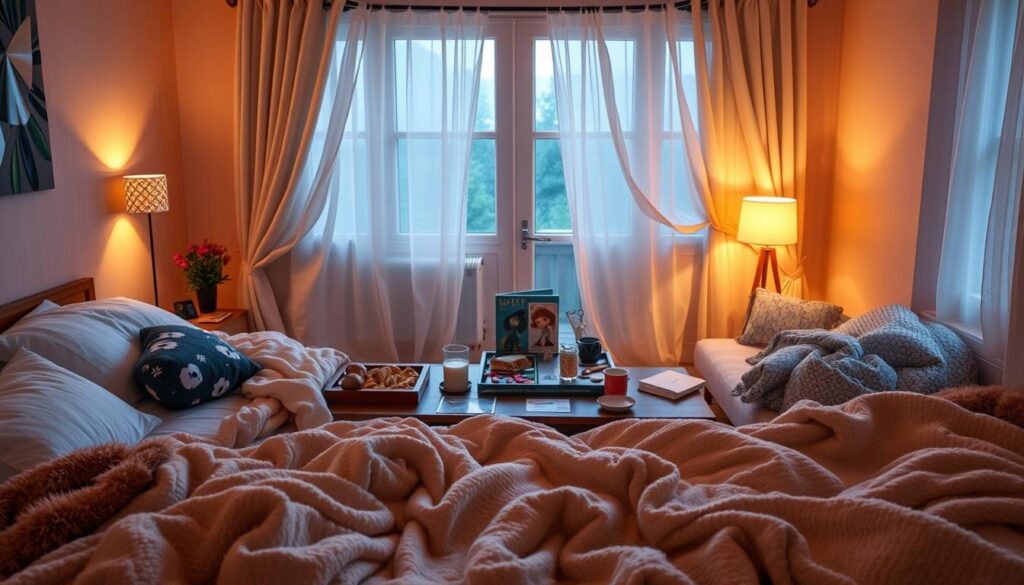
Good communication is key when hosting a sleepover. About 65% of parents use text or social media to talk about plans. It’s also important to ask about food allergies and dietary restrictions – 75% of parents worry about this.
Set clear rules for bedtime and device use. 50% of parents make sure kids stick to a sleep schedule. This helps them get enough rest. Also, 30% of kids struggle without their devices.
“Sleepovers contribute positively to children’s social skills and friendships.” – 72% of parents agree
By planning carefully and considering these points, you’ll make sure your child’s sleepover is fun and safe.
3 Essential Ground Rules for a Successful Sleepover
Hosting a sleepover can be a blast, but it needs careful planning. Setting clear rules ensures everyone has fun and gets enough sleep. Let’s look at key guidelines for a great sleepover.
Setting Clear Boundaries
Make and share house rules early on. This includes what areas are off-limits, expected behavior, and what happens if rules are broken. Clear rules make kids feel safe and avoid confusion.
Establishing Quiet Hours
Quiet hours are key for a good night’s sleep. Decide when it’s time to be quieter. This helps kids relax and get ready for sleep. Start by slowly reducing activity as the night goes on.
| Time | Activity Level | Noise Level |
|---|---|---|
| 7:00 PM – 9:00 PM | High | Normal |
| 9:00 PM – 10:30 PM | Medium | Reduced |
| 10:30 PM – Bedtime | Low | Quiet |
Device Usage Guidelines
It’s important to manage device use at sleepovers. Think about taking phones before bed. This helps kids sleep better and talk more face-to-face. It also cuts down on social media problems.
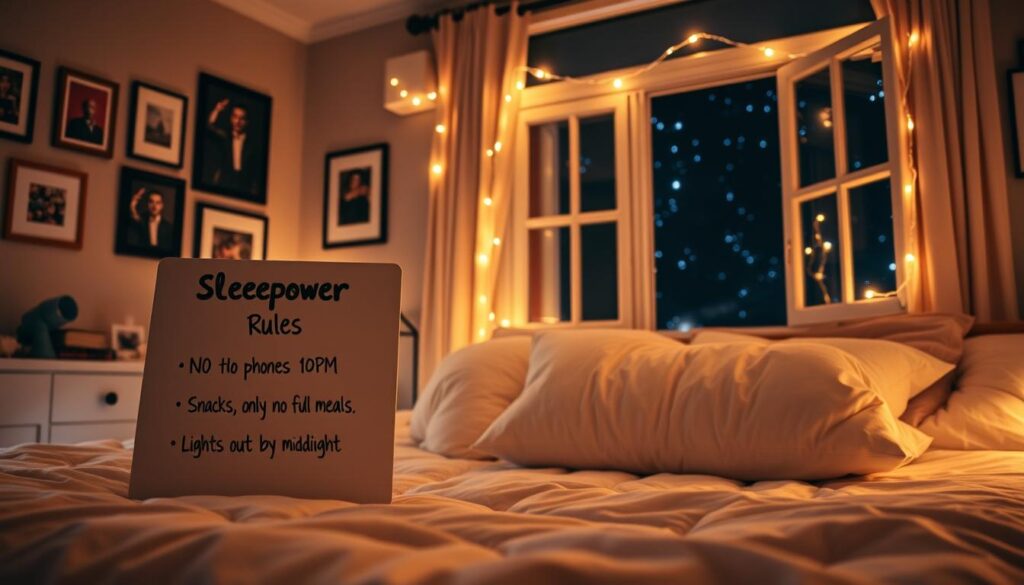
Clear rules make for a safe and fun sleepover. By setting boundaries, quiet hours, and managing devices, you’re setting up a great night. Kids will have fun and get the rest they need.
[lasso id=”1758″ link_id=”366″ ref=”amzn-lectrofan-evo-guaranteed-non-looping-sleep-sound-machine-with-22-unique-fan-sounds-white-noise-variations-and-synthesized-ocean-sounds-with-sleep-timer”]
4 Creating a Sleep-Friendly Environment
A sleep-friendly environment is key for rest during sleepovers. Let’s look at how to make the best sleep conditions for your young guests.
Optimal Room Temperature and Lighting
Keep the room temperature between 60-67°F (15-19°C) for comfy sleep. Use blackout curtains or eye masks to block light and improve sleep. Dim lights an hour before bed to signal it’s time to relax.
[lasso id=”1572″ link_id=”367″ ref=”amzn-bgment-white-blackout-curtains-for-bedroom-black-out-curtains-63-inch-long-thermal-insulated-grommet-total-room-darkening-window-drapes-for-living-room-2-panels-42-x-63-inch”]
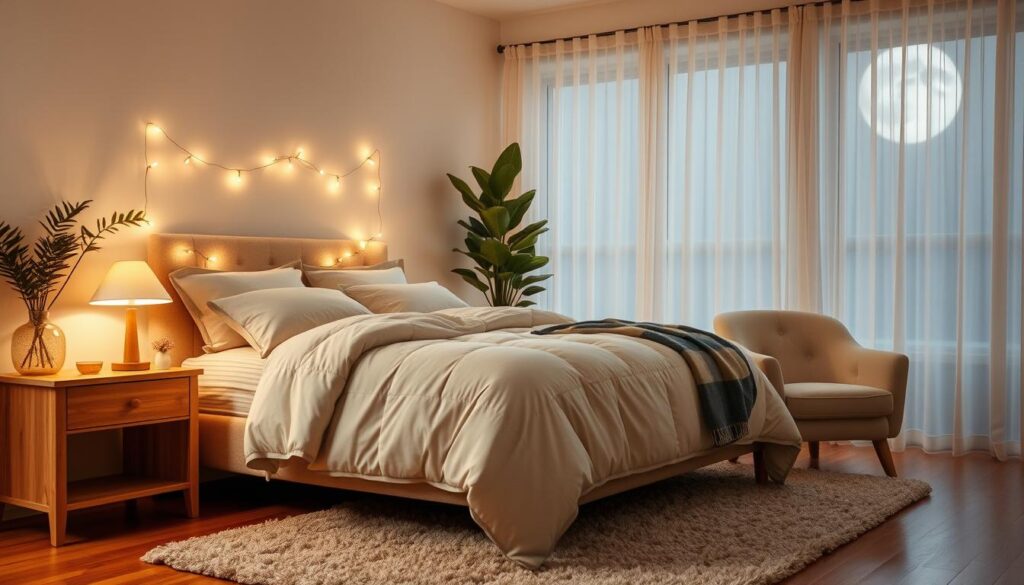
Comfortable Sleeping Arrangements
Give each child a cozy sleeping bag or air mattress. Make sure there’s enough space between beds to avoid disturbances. Offer extra pillows and blankets for their comfort.
Noise Control Strategies
Use noise control to keep the sleep area quiet. White noise machines or soft music can help block out loud sounds. Create quiet zones away from main sleeping areas for early risers.
- Set ground rules for noise levels after lights out
- Place noisy electronics in a separate room
- Use carpets or rugs to absorb sound
By focusing on these areas, you’ll make a sleep-friendly space. It balances the fun of a sleepover with the need for rest. Teaching kids to value sleep early on is a valuable life skill.
5 Timing and Schedule Management

Creating a balanced sleepover schedule is key to ensuring kids have fun while getting enough rest. A well-planned timeline helps manage energy levels and prevents overtired, cranky kids the next day. Let’s explore some strategies for effective activity timing and bedtime management.
Start by planning engaging activities for the early evening. This could include games, crafts, or watching a movie. As the night progresses, gradually introduce calmer activities to naturally wind down the energy levels. Aim for a “lights out” time around 11 PM – studies show this helps prevent next-day crankiness in 40% of cases.
Here’s a sample sleepover schedule to guide your planning:
| Time | Activity |
|---|---|
| 6:00 PM | Arrival and welcome |
| 6:30 PM | Pizza dinner |
| 7:30 PM | Active games |
| 9:00 PM | Movie time |
| 10:30 PM | Quiet chat and snacks |
| 11:00 PM | Bedtime prep |
| 11:30 PM | Lights out |
Remember, flexibility is important. Be prepared to adjust your sleepover schedule based on the group’s energy levels. Gently guide kids towards rest when it’s time, perhaps by introducing a calming bedtime story or soft music. With thoughtful activity timing and bedtime management, you can ensure a fun and restful sleepover experience for all.
6 Sleepover Survival Guide: How to Actually Get Rest (Not Just Stay Up All Night)
Sleepovers are fun for kids, but they can lead to not enough sleep. Kids might only sleep for an hour or two, which can hurt their school work for days. To make sleepovers successful, it’s important to use good rest strategies and manage energy well.
Practical Rest Strategies
It’s important to balance fun and rest at sleepovers. Plan activities that help kids wind down as the night goes on. Here are some tips:
- Set a reasonable bedtime and stick to it
- Incorporate calming activities like reading or gentle music before sleep
- Provide comfortable sleeping arrangements for all guests
[lasso id=”1759″ link_id=”368″ ref=”amzn-anfie-weighted-blanket-kids-36×48-5lbs-weighted-blanket-cooling-blanket-for-sleepingthrow-size-breathable-blanket-with-premium-glass-beadspace-grey”]
Managing Energy Levels
Managing energy is key for a great sleepover. Start with fun, high-energy activities and then move to quieter ones. Here’s a sample schedule:
| Time | Activity | Energy Level |
|---|---|---|
| 7:00 PM | Active games | High |
| 8:30 PM | Movie time | Medium |
| 10:00 PM | Quiet conversation | Low |
| 11:00 PM | Bedtime routine | Very Low |
Creating Quiet Time Zones
Make quiet zones where kids can take a break from all the fun. This helps respect everyone’s energy and sleep needs. Choose a room or area for a ‘chill-out zone’ with soft lights and comfy seats.
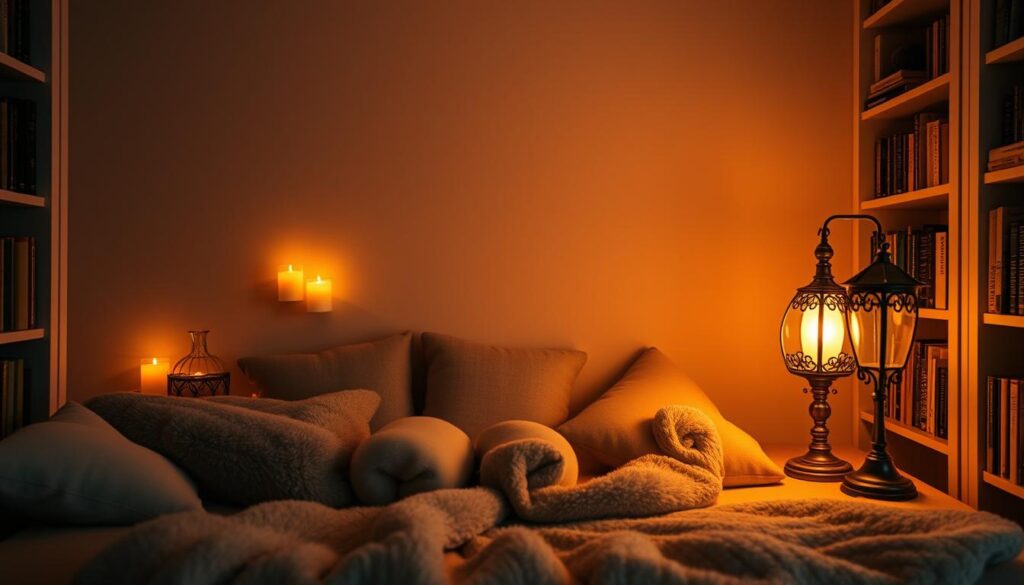
By using these strategies, kids can get the rest they need at sleepovers. This makes the experience fun for everyone.
7 Food and Drink Considerations
Choosing the right sleepover snacks is crucial for a good night’s sleep. It’s important to find a balance between fun treats and healthy options. Let’s explore some smart choices for food and drinks that won’t disrupt sleep.

When picking snacks, avoid high-sugar foods before bed. These can cause energy spikes followed by crashes, making it hard to sleep. Instead, opt for protein-rich snacks that keep kids alert without the sugar rush.
- Carrot sticks and celery
- Apple slices with peanut butter
- Mixed nuts like almonds and cashews
- Cheese cubes with whole grain crackers
[lasso id=”1760″ link_id=”369″ ref=”amzn-planters-deluxe-salted-mixed-nuts-roasted-cashews-almonds-brazil-nuts-pistachios-and-pecans-party-snacks-plant-based-protein-quick-snack-for-adults-after-school-snack-15-25oz-canister”]
Limit caffeine in drinks. Sodas and energy drinks can make it tough to fall asleep. Water is always a great choice. You could also try caffeine-free herbal teas or milk, which can help promote sleep.
| Snack Type | Benefits | Examples |
|---|---|---|
| Fruits | Natural sugars, vitamins | Apples, bananas, berries |
| Vegetables | Low-calorie, fiber-rich | Carrot sticks, cucumber slices |
| Proteins | Promotes alertness | Nuts, cheese, yogurt |
| Whole Grains | Steady energy release | Popcorn, whole grain crackers |
Remember, timing is key. Serve main snacks earlier in the evening. As bedtime approaches, switch to lighter options. This helps kids wind down naturally for a good night’s sleep.
8 Managing Group Dynamics
Group dynamics are key to a successful sleepover. Making sure everyone feels included is crucial for a good night’s sleep for all.
Preventing Cliques and Exclusion
To stop cliques, plan fun activities that bring everyone together. Switch up who plays with whom in games. This helps everyone make new friends and feel included.
Handling Personality Conflicts
It’s important to solve conflicts quickly. Teach kids to say “I” when sharing feelings and listen well to others. Encourage finding common ground when disagreements happen.
Supporting Shy or Anxious Children
For shy or anxious kids, have a quiet spot for them to go if needed. Pair them with a friend to help them feel better. Offer calm activities like coloring or reading for a break from loud games.

| Factor | Impact on Group Dynamics | Improvement Strategy |
|---|---|---|
| Sleep Deprivation | 20% increase in irritability | Implement structured sleep schedules |
| Rest Opportunities | Only 25% feel adequate | Create quiet retreat spaces |
| Sleep Rules | 50% of hosts implement | Establish clear guidelines for all |
| Group Satisfaction | 30% increase with rest | Balance activities with downtime |
By focusing on these group dynamics, you can make sleepovers more fun and restful for everyone.
9 Safety Protocols and Parent Communication
Sleepover safety is crucial for parents and hosts. It starts with clear talks between everyone. Before the sleepover, get important info from parents, like emergency contacts and any special needs.

Make a list of house rules and share them with kids and parents. This way, everyone knows what’s expected. Talk about things like phone use, quiet times, and off-limits areas.
Have emergency plans ready and tell all adults about them. Keep a first aid kit handy and know where the nearest hospital is. A plan is key for unexpected situations.
- Collect emergency contact information
- Discuss allergies and dietary restrictions
- Establish and communicate house rules
- Prepare a first aid kit
- Know local emergency services
[lasso id=”1761″ link_id=”370″ ref=”amzn-keepgoing-large-home-first-aid-kit-for-kids-270-pc-first-aid-kit-for-car-home-dorm-boat-with-latex-free-bandages-10-x-7-x-3-5-in-travel-first-aid-kit-signature”]
Keep talking to parents even after the sleepover starts. Be ready to handle any worries that come up. If a child feels homesick or anxious, have a plan to reach out to parents without disturbing others.
Being open and honest with parents builds trust. It makes sure everyone has a great time. Focus on safety and clear communication to make the sleepover fun and stress-free for all.
10 Activities That Promote Natural Wind-Down
Planning wind-down activities is key to a successful sleepover. These activities help kids transition from excitement to rest. This ensures everyone gets the sleep they need.
Calming Games and Activities
Quiet games promote relaxation without overstimulating. Try gentle yoga stretches, coloring books, or a calm scavenger hunt. These activities reduce stress and prepare the body for sleep.
Movie Selection Guidelines
Choosing the right sleepover movies is crucial. Opt for light-hearted, familiar films that won’t cause excitement or fear. Animated features or family comedies work well. Keep the volume low and consider using subtitles to further reduce stimulation.
Quiet Conversation Topics
Encourage soft-spoken chats about positive subjects. Discuss favorite memories, dream vacations, or fun school projects. These calming conversations help wind down the mind without energizing it.

| Activity Type | Examples | Benefits |
|---|---|---|
| Calming Games | Gentle yoga, coloring, quiet scavenger hunt | Reduces stress, prepares body for sleep |
| Sleepover Movies | Animated features, family comedies | Entertains without overstimulating |
| Quiet Conversations | Favorite memories, dream vacations, school projects | Winds down the mind, promotes relaxation |
By incorporating these wind-down activities, you’ll create a relaxing atmosphere. This helps everyone transition to sleep naturally. Ensuring a restful night for all sleepover participants.
11 Dealing with Homesickness and Anxiety

Sleepovers are fun, but they can also make kids feel homesick and anxious. About 25-30% of kids feel homesick at their first sleepover. But, there are many ways to make them feel better.
Positive coping methods are very helpful. For 60% of kids, focusing on the fun moments helps them feel better. Talking about their worries also helps, with 70% feeling relieved afterward.
Here are some effective ways to ease homesickness:
- Bring a favorite stuffed animal or blanket (helps 40% of children)
- Try breathing exercises (calms 50% of anxious kids)
- Offer quiet activities like reading or listening to music (soothes 65% of children)
[lasso id=”1762″ link_id=”371″ ref=”amzn-little-giraffe-little-g-giraffe-blanky-animal-security-baby-blanket-14-x-14-blue”]
Parents are key in helping kids feel better. Talking about homesickness before the sleepover helps 80% of kids. If a child is really upset, it’s okay to let them call home. About 30% of kids do this during their first sleepover.
With the right support, most kids can beat homesickness and have a great time at sleepovers!
12 Morning After Management
The morning after a sleepover can be chaotic. It’s important to manage it well to end on a high note. We’ll look at how to handle wake-up routines, breakfast, and cleanup.
Wake-up Routines
Starting the day with a gentle routine is key. Use soft music or natural light to wake up kids. This helps everyone adjust to the new day.
Breakfast Planning
Breakfast is crucial for a good morning. Choose something simple yet tasty that everyone will enjoy. Here’s a quick breakfast idea:
| Item | Preparation Time | Serving Size |
|---|---|---|
| Pancakes | 15 minutes | 2-3 per person |
| Fresh Fruit | 5 minutes | 1 cup per person |
| Yogurt | No prep | 1/2 cup per person |
Clean-up Strategies
Get everyone involved in cleaning up. Make it fun by turning it into a game. This way, everyone helps and it’s more enjoyable.

Managing the morning after a sleepover well makes future gatherings better. Focus on smooth wake-ups, tasty breakfasts, and quick cleanup. This way, you’ll make memories that last.
13 Parent Survival Strategies
Hosting a sleepover can be tough for parents. With the right tips, you can handle sleepover stress. Let’s look at some ways to survive and enjoy these fun but tiring events.

Sleep deprivation is a big problem for parents at sleepovers. Studies show parents get only 4-5 hours of sleep when kids are around. To fight this, try going to bed early a few nights a week. This can help you sleep better and get ready for the sleepover.
Setting up a bedtime routine is good for you and the kids. It can make everyone sleep better. Think about making a cozy sleep area with night lights and soft toys to help kids relax.
- Establish clear quiet hours
- Prepare comfortable sleeping arrangements
- Plan calming activities before bedtime
- Limit screen time in the evening
It’s key to find a balance between being there for the kids and giving them space. By age 5, most parents want their kids to sleep alone. During sleepovers, this balance is even more important.
“Sleepovers are a great chance for kids to learn social skills and be independent. But they can be stressful for parents. The trick is finding the right mix of watching over them and letting them have fun.”
Lastly, don’t forget to take care of yourself. Make time for peace during the sleepover. This could mean taking short breaks, enjoying a quiet tea, or getting some fresh air. Taking care of yourself helps you deal with any sleepover challenges.
14 Emergency Situations and Solutions
Sleepover emergencies can pop up, but with the right skills, you can manage them. Being ready is crucial for a safe and fun time for all.
Common Problems and Solutions
Sleepovers bring unexpected issues. Homesickness hits 75% of kids, causing emotional pain. Make a cozy space and have fun activities ready.
Dietary worries affect over 50% of parents. Always check about food allergies and restrictions before.
When to Contact Parents
Knowing when to call parents is important. If a child is very homesick or seems sick, call them right away. About 30% of sleepovers end early, by 9 PM, to keep bedtime routines.
First Aid Essentials
A good first aid kit is key for minor injuries. Stock up on bandages, antiseptic wipes, and pain relievers. For serious issues, like allergic reactions or injuries needing a doctor, call emergency services fast.
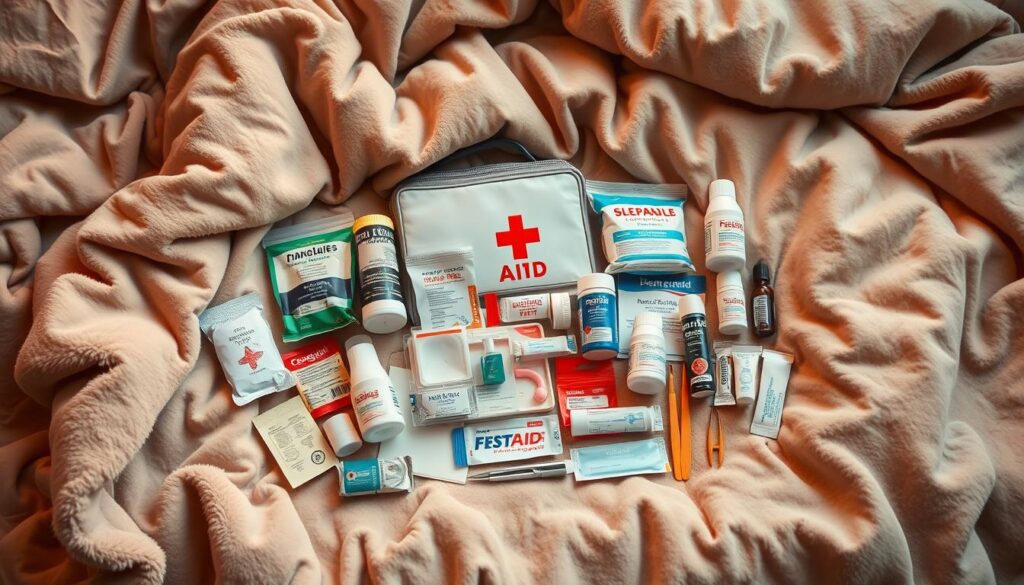
Being ready for sleepover emergencies is more than just having supplies. It’s about staying calm, making smart choices, and knowing when to ask for help. With these skills, you’ll be ready for anything that comes up at your next sleepover.
15 Age-Appropriate Modifications
It’s important to tailor sleepover plans for different ages. This ensures everyone has fun and gets enough sleep. Let’s look at how to adjust activities and expectations for various age groups.
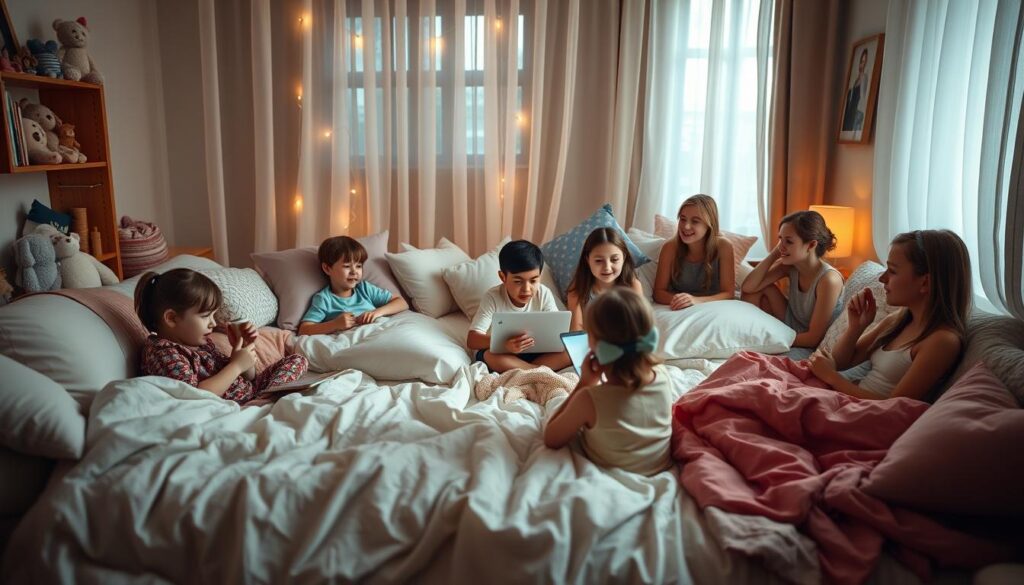
For kids under 10, it’s all about structure. They need more guidance and go to bed early. Make sure to pack a toothbrush, hairbrush, and a change of clothes. A pillow and sleeping bag are also good for comfort.
Tweens, between 10 and 12, want more freedom. They might bring extra toiletries and snacks. They love themed pajamas, like Frozen or Harry Potter.
Teenagers need a mix of freedom and supervision. They might want to stay up later and need reminders about phones. Don’t forget to pack phone chargers and personal items.
| Age Group | Bedtime | Key Considerations |
|---|---|---|
| Under 10 | 8:30 PM – 9:30 PM | Structured activities, early wind-down |
| Tweens (10-12) | 9:30 PM – 10:30 PM | Balance of activities and rest, themed fun |
| Teenagers | 10:30 PM – 11:30 PM | More independence, device management |
Keep in mind, these are just guidelines. Every child is different. Be flexible with your plans. By considering their developmental stages, you’ll make sure everyone has a great time and gets enough sleep.
16 Conclusion
Sleepover success comes from finding the perfect mix of fun and rest. Parents can make these events special by following the tips in this guide. It’s all about planning well, talking clearly, and being flexible.
Sleepovers are more than just fun. They help kids learn important social skills, become more independent, and build resilience. With the right help, these events can be great for kids’ growth, making sure everyone gets enough sleep.
It’s clear that sleepovers can be both fun and restful. By setting rules, making a cozy sleep area, and handling group issues well, parents can make these nights memorable. The hard work in planning sleepovers leads to happy, well-rested kids and strong friendships.










